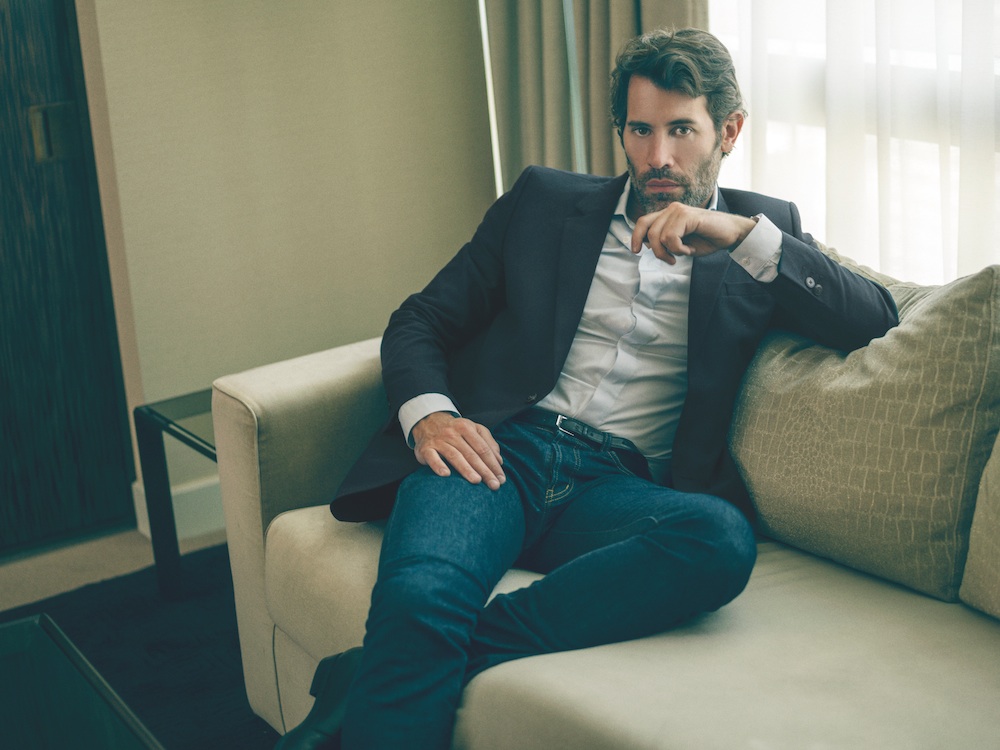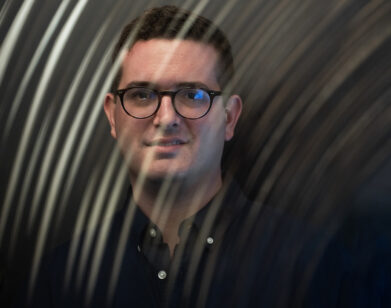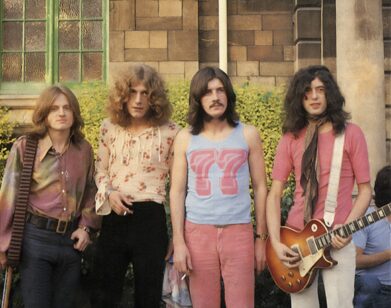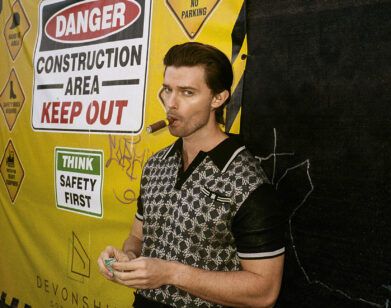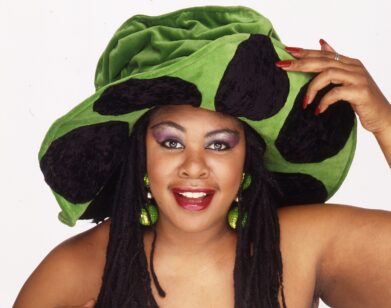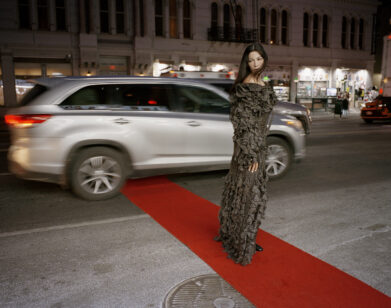Jalil Lespert Uncovers An Icon
In fashion, sometimes logos get to the point before the clothes. Be it the blocky, interlocking Cs of Chanel, the Old World overlaid serifs of Louis Vuitton’s LVs, or the clean utilitarian CKs of Calvin Klein—heritage, identity, and consumerist desire find themselves encapsulated in a simple monogram. In the case of Yves Saint Laurent, the sinuous, elongated vertical lines of the YSL logo, designed in 1961 by Adolphe Mouron Cassandre, and stamped on everything from the brand’s cosmetics cases, handbags, et al. up until Hedi Slimane’s 2012 rebranding, indicate a certain timeless elegance synonymous with the maison‘s iconic and idolized founder.
“Chanel freed women, and I empowered them,” the Algerian-born couturier once said. He wasn’t far off; counting the safari jacket, the le smoking tuxedo, the Mondrian shift dress, and pants for women—for both day and evening wear—Saint Laurent tapped into the political upheaval of the ’60s and ’70s, upending the social and sexual paradigm. Saint Laurent’s restless hands and fragile genius fashioned some of the most directional clothing of the 20th century. His iconoclastic designs often shocked with their ingenuity before becoming the standard of high chic. While Saint Laurent revolutionized couture and legitimized ready-to-wear, however, by his side through it all was his partner in business and in life, Pierre Bergé.
It was the fierce, unwavering partnership between Saint Laurent and Bergé that drew César Award-winning French actor and filmmaker Jalil Lespert to create a biopic of Saint Laurent (played transcendently by newcomer Pierre Niney). The film, which comes out in limited release this week, is carefully crafted through the eyes of his lover, spanning from the designer’s early days as Christian Dior’s assistant, to courtship with Bergé (Guillaume Galliene), the launch of his eponymous couture house, series of muses (including Victoire Doutreleau (Charlotte Le Bon), Betty Catroux (Marie de Villepin), and Loulou de la Falaise (Laura Smet), and descent into depression, drug, alcohol, and sex addiction. The pair split romantically in the late ’70s, but remained companions, and shortly before Saint Laurent’s death, of brain cancer at age 71 in 2008, he and Bergé were married in a civil union in Paris.
Lespert met with Bergé early on in the production process of Yves Saint Laurent, and not only did Bergé granted him access to the designer’s well-preserved archive and the pair’s villa in Marrakesh, Morocco, but his personal perspective on the couple’s 50-odd years together. “I asked him once,” Lespert says. “‘How did you live with Yves?’ He said it was a nightmare sometimes— he was a drug addict, a sex addict. He told me the truth, ‘I never stopped admiring him.'”
Interview met with Lespert recently while he was in New York.
COLLEEN KELSEY: As an actor and filmmaker, how familiar were you with Yves Saint Laurent and his life before you started this project?
JALIL LESPERT: I wasn’t particularly close to the universe of Saint Laurent, but what I did was I started to look at historical people. I felt responsibility in terms of speaking of him, and especially towards the public, in getting to have him known better. His story is not actually very well known. But at the same time, since he is an icon, I had to take a certain amount of distance, in terms of the reality of the story and not weighing down the story too much. It was the same thing with the actors. We worked intensely and uphill. We tried to de-dramatize the story because we didn’t want to make a film that looked like a wax museum; we wanted to make a film that was alive.
KELSEY: At what stage in preparing the film did you connect with Pierre Bergé?
LESPERT: I went to see Pierre Bergé before anything started, because I knew that I wanted to talk about Yves Saint Laurent through the eyes of Pierre Bergé. It’s such a great, beautiful love story, and I have such immense respect for it, that I felt that it was the natural, right thing to do to go and see him, because the story has such elegance and power. And of course, there was an ulterior motive because I needed the support of the foundation [Fondation Pierre Bergé-Fondation Yves Saint Laurent], because I didn’t want to make copies of the clothing. I wanted to be able to use the originals. I wanted it to be as precise as possible, and I needed him for that.
KELSEY: How rigorous was the costume design in recreating these historic moments, like Saint Laurent’s first collection for Dior, or the 1976 Ballets Russes collection?
LESPERT: It was double work for the costumers. For the film and all of the characters, of course, they needed their own creations. They did it very well, and also there was huge work with the archive because all of the catwalks that we see in the movie… I didn’t want to make copies, of course. It would be impossible to make copies if I wanted to, because the materials don’t exist anymore. It was double work, really. But it was amazing, fantastic.
KELSEY: When working with Pierre Niney, did you encourage him to meet with Pierre at all? Did they work closely together?
LESPERT: They met once or twice. Not too much. First of all, Pierre Bergé is extremely busy—despite his age, he travels enormously. And in terms of the icon of Yves Saint Laurent, the actor is to feel free and to do a movie. I don’t want them to be too close to reality. But of course I managed to organize a lot of meetings with different people who worked with Yves Saint Laurent, like writers and his personal assistant. She was very important, very close to him personally and professionally. There were of course other people, like Betty Catroux, and workers, like the seamstresses and the couturiers.
KELSEY: Before, you mentioned your interest in Yves as a historical figure. What about him did you learn about most through making this film?
LESPERT: Extraordinary dimensions of the artist and who he was. It was an opportunity for me to talk about creation and where it comes from. With someone like Yves Saint Laurent, it’s definitely coming from illness and the struggle against it. It was very interesting to talk about that, because not a lot of people really know about it. It’s a part of his life that’s very mysterious and secret, because he didn’t want people to know about it, of course. So there’s a lot of mystery around that, and I wanted to make it very clear because for a lot of artists malice is often the key of creation. You have to create to feel better, and you need to feel better, too, to create. It’s really weird, but it works like that. I believe in it, especially when you talk about a genius. Yves Saint Laurent, even Jimi Hendrix. People like that.
KELSEY: I think it’s an incredible indicator of Bergé’s character, and his love for Yves, that he took over everything Yves needed to do in public life, be it doing interviews or the nitty-gritty of running a fashion house, and did it for him, to free him from the business aspect of fashion and redirect him towards creation. How do you think he feels seeing himself on the screen portrayed by someone else?
LESPERT: He was very moved. First of all, he’s old. He had this sentence that was very weird in the moment when he saw the movie. He said, “This is it. It’s done.” I think he means, “Now, he’s really dead.” It was very moving to see as a human being. He was important for Yves’ creation and life. He knows that already. It was not just like, “Oh, I was like that. I didn’t realize.” He’s very smart. He also knew that Yves Saint Laurent was very important in his life. The connection was almost perfect.
KELSEY: What do you think is Saint Laurent’s lasting influence?
LESPERT: In fashion, of course, the way that women are dressed now—and also a vision of the modern woman, the woman of today. She’s very feminine, but at the same time, extremely free. A Saint Laurent woman is actually very Parisian. She’s not really a man’s equal, she’s his adversary. I like this idea of being more than equal, because his generation was fighting for equality, but it’s more than that. For example, I was very lucky because I worked on the catwalk with two models who worked with Yves Saint Laurent for more than 10 years. They’re not just gorgeous models, they’re more than that—they’re very smart and very beautiful, elegant. They’re more than models, they’re really unique; it’s personality. It’s more than just fashion.
KELSEY: That’s clear in the women he was fascinated by; whether it’s Betty Catroux or Iman or Catherine Deneuve. He was quite astute in terms of tapping into what kind of behaviors were progressive or becoming outmoded. You can see that in the film when he was over Victoire [Doutreleau] as a muse and he was on to the next thing.
LESPERT: It’s my own interpretation, but when I read that Pierre Bergé had sex with Victoire, I was just like, “Really?!” [laughs] It’s a bit secret. I was really wondering why. And I suddenly realized that it was the same moment a few weeks after that, that Yves fired her. It was quite obvious that it was impossible to do three in the same couple. Pierre killed the third one. He protected this couple from news, addictions, everything. Sometimes it could be a good thing, to protect Yves, but sometimes it would be like a gangster movie, and he would kill. [laughs]
KELSEY: You do show these dark moments where Yves conflicted with Pierre, calling him a parasite, etc. But they truly did have a symbiotic relationship.
LESPERT: Of course. But, I didn’t want to go too much in the dark side, because it’s easy. When I started the project I was like, “Yeah, I want to do a lot of back rooms, drug addict scenes.” But more and more I realized that it wasn’t necessary when you talk about someone like Yves Saint Laurent. Of course you have to talk about it, but it’s not the most important—too many clichés. It’s a part of the deal when you’re talking about a genius. It’s always a rise and fall, because you pay the price of genius.
KELSEY: Is that why you decided to end the film at that Ballet Russes collection?
LESPERT: It’s a paradox. The Ballet Russes, for me, is the best collection of his, maybe one of the best collections in fashion history. The paradox is particular. Yves and Pierre hate each other, almost, and because of creation they meet each other again. It’s the meaning of life and a love story. If you’re not able to cross the moment and go through that, and continue to love each other, it’s not love, it’s just sex, or infatuation. They decided to cross life together. That’s the best thing that we can live.
YVES SAINT LAURENT OPENS IN LIMITED RELEASE JUNE 25.

